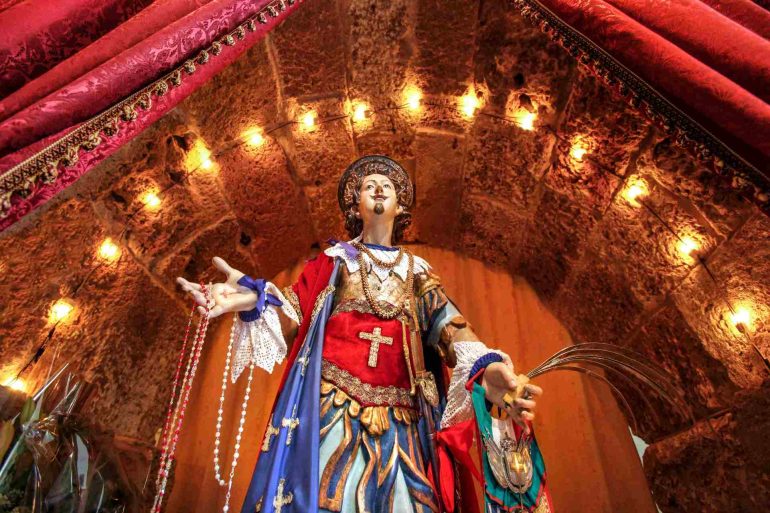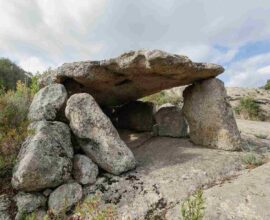Vows and miracles of Sant’Efisio: history of the Sardinian festival
History, traditions, customs and schedule of the celebrations dedicated to Sant’Efisio, the Sardinian people’s Patron Saint
Celebrated since 1652, the ancient Festival of Sant’Efisio has gone beyond its purely religious dimension over the years and contributed to the construction of an important side of the cultural identity of the whole Sardinia, especially of Cagliari.
Among many religious celebrations that have contributed to the construction of Sardinian identity and culture over the centuries, the Festival of Sant’Efisio surely stands out. A celebration which for almost four centuries has paid homage to the warrior-martyr, who freed Sardinia from the Great Plague of the mid-seventeenth century appearing in a vision to the Count of Lemos.
A true miracle that defined the fate of the Island, therefore deserving of being celebrated at best. In fact, the Festival of Sant’Efisio is not a conventional event, including a very long pilgrimage over 60 kilometers long that starts in the morning on April 25 in the historic district of Stampace and, passing first through the churches of Giorgino and Su Loi (Capoterra), Villa d’Orri, Sarroch, Villa San Pietro and Pula, finally comes to the ancient city of Nora in the morning of May 1: that’s the place of the martyrdom of Sant’Efisio.
A colorful and endorsed procession, which captivates even those who generally don’t like this kind of event, speaks right to the soul and evokes ancient and intense feelings, a magic that only such a faithful community can arouse.
So it’s not surprising that the Festival of Sant’Efisio can gather thousands of people in celebrations, just like the evocative Corsa degli Scalzi of Cabras (Cabras Barefoot Run), suggestive moments to enjoy with the melodies of old songs of devotion, the goccius, whose pathos is enhanced by the notes of ancient wind polyphonic musical instruments called launeddas. These melodies follow the whole parade, counting thousands of participants dressed in bright traditional clothes preceded by traccas, traditional sumptuous wagons embellished with flowers and fruit pulled by oxen adorned with floral garlands, true kind of “mobile houses” which carry the simulacrum of Sant’Efisio.
History of the vows of Sant’Efisio, a four centuries lasting devotion
To retrace the events that led to the origins of the Festival of Sant’Efisio it’s necessary taking a leap back in time, almost four centuries ago, in 1652. The city of Cagliari was devastated by one of the most virulent Plague epidemics in history, which had quickly decimated the population without showing any signs of its end.
In a desperate attempt to solve this dramatic situation, on July 11, 1652 the local authorities, following the indication of the Count of Lemos, decided to ask for help with a solemn vow to Sant’Efisio committing the people of Cagliari to pay homage for his intercession every year on May 1 with a solemn celebration.
But why did they ask Sant’Efisio for aid? Efisio was a Roman praetorian born in Elia Capitolina, a city near Antioch (in present-day Turkey), in 250 AD, who was sent to Italy to fight in the military campaign to annihilate Christians, considered enemies of Rome.
According to what tells the “Passio Sancti Ephisii”, the first official document about the Saint, here Efisio was captivated by the divine light and converted to the Christian faith, deciding to be baptized in Caieta (now Gaeta) shortly before being transferred to Sardinia, more precisely to the military command of Nora, to leadt he fight against Iliesi, rebel populations coming from the hinterland of the island.
Contrary to the anti-Christian edicts issued by Diocletian, Efisio decided to join a work of religious conversion within the local populations and even soldiers, attracting so many followers to the point of being punished several times by the local governor. His obstinate refusal to abandon the Christian faith forced authorities to lock him up in a cell located in nowadays Stampace, a district in Cagliari (exactly in the place where today stands the Church from which the procession starts), flagellate him, strip him of his own flesh, burn him with scorching coals, and finally behead him on the beach of Nora on January 15, 286 (but according to other sources it happened in 303, instead).
Myth tells that right before his death, Efisio promised eternal protection to Cagliari and its inhabitants who had always supported him, an act of extreme loyalty that did not fail even more than one thousand years later, when the Saint welcomed the prayers of the people of Cagliari and put an end to the Plague.
In September 1656 the epidemic began to slow down until it completely disappeared between 1656 and 1657; to celebrate it, from May of the same year (1657) the procession of Sant’Efisio retraces every year the route that connects the most important places concerning Efisio, such as Nora where the martyr spent his last days, before returning to Cagliari.
This festival, with its traditions, has long become one of the most heartfelt religious celebrations in Sardinia, so much so that the commitment sealed with the Saint didn’t fail even during the WW2 when, among the crumbled buildings in the city due to bombings in 1943, the statue of Efisio was still carried in procession. The same thing happened again in the case of Covid 19 pandemic, an act speaking of devotion and hope for a better future.
Sant’Efisio, a mix of bright colors, scented rituals and emotional chants
At its 368th edition, the Festival of Sant’Efisio has now become a fundamental part of the rich Sardinian cultural heritage, made up of highly codified traditions, songs and rituals that have been handed dow nunchanged for centuries, showing gratitude and pride felt by the people of Sardinia towards the main protagonists who contributed to shape relevant pages in the history of the island.
That’s why the Procession of Sant’Efisio, one of the longest in Europe with its 65km length, never ceases to exert a strong attraction both on devotees and on tourists from everywhere, enchanted by the joyful atmosphere, the colors and sounds, and the feeling of gratitude and hope that characterizes the first days of May in Cagliari. A unique festive moment in the middle of springtime, which transcends the purely religious sphere to enter the identity and cultural spheres, hence creating that sense of community that’s difficult to put into words, but which appears immediately evident as soon as you join the celebrating crowd.
It is no coincidence that the preparations for the pilgrimage involve thousands of people and are not limited to the weeks preceding the actual event, but they take the whole year. Starting from the preparation and care of traditional clothes, often embellished with precious embroidery, to the decoration of the festive wagons and the carriages and the exercises of horses and knights (the Militia, the Campidanesi and the Guardiania), wearing the ancient red jackets and opening to the passage of the Saint’s statue.
All things that certainly cannot be left to last minute preparation, requiring time, dedication and a lot of passion. The same goes for the very fragrant ritual of sa ramadura, the scattering of pink, yellow and red flower petals and scented essences along the trail traveled by the chariot carrying the simulacrum, creating a bright floral carpet that adds a mystic and olfactory dimension to the ritual, perhaps the sense that best manages to imprint itself on the memory evoking new and unique emotions.
Providing the background to the procession there are the emotional songs of devotion sung by cuncordu formations, a particular and typical form of Sardinian singing which usually includes four male parts, each one performed by a single specialized singer member from a religious brotherhood, according to tradition.
The majesty of the Festival of Sant’Efisio is expressed in all its strength when the wagon carrying the statue of the martyr crosses the town hall, where the procession stops for a while to receive the homage of th ecommunity with the glorious sounds of bells and sirens of the ships in the port.
But this is not the end of the event, for sure, it’s just the beginning. In fact the entire road to Nora beach is still missing, a journey on which the Saint’s statue travels on a simpler chariot to get there only the following morning after having a night stop in the village of Sarroch. The celebration in the place of Efisio’s martyrdom lasts for two days, before returning to the city on May 4, emotionally welcomed by thousands of faithfuls.
In short, an awesome event as the Vow made to the Holy Protector of the Sardinian People.
Festival of Sant’Efisio: the complete schedule of 2024 celebrations
Here is the complete schedule of the events related to the Festival of Sant’Efisio 2024, from April 25 to May 4:
- April 25, 2024
In preparation for the procession, at 10 am at the Church of Sant’Efisio in Stampace will begin the arrangement of the chariot for carrying the simulacrum of Sant’Efisio, and the flag and banners will be handed over to the militiamen.
- April 29 and 30, 2024
On 29, at 6 pm the ceremony continues with the dressing of the simulacrum with the celebration clothes; while on 30, at 10 am, there’s the ornamentation of the statue with golden vowing decorations, followed at 12 noon by the Holy Mass to bless the enthronement of Sant’Efisio on his wagon and in the evening, at 9 pm, by the solemn prayer vigil that precedes the actual ceremony.
- May 1, 2024
The main day of celebration, starting at 10 am with the long pilgrimage that will bring the simulacrum of the Saint from Cagliari to Nora, featuring the colorful traccas, the devotees dressed in traditional costumes and the knights. The chariot of Sant’Efisio will begin its journey at 12 noon, crossing the centre of the city and the town hall, going on its path with several stops up to Sarroch, where the participants will rest and spend the night.
- May 2, 2024
The celebrations continue in the Church of S. Vittoria in Sarroch, where at 7 am the Holy Mass will officially bless and announce the next stage of the pilgrimage, which will arrive at 2:30 pm in Pula at the Church of San Giovanni Battista first, leaving again towards Nora at 6 pm to get there around 7 pm when the Holy Mass in the local Church of Sant’Efisio will take place.
- May 3, 2024
At 8 am the celebration starts with the Holy Mass, followed by the Solemn Pontifical at 11 am and the Solemn Procession at 6 pm, during which the statue of Sant’Efisio will be carried along the path leading to the excavations of Nora with a return from the beach to the Church of San Giovanni Battista in Pula. At the same time, in Cagliari, from 7.30 pm there will be the celebration of a Holy Mass in the main Church of Sant’Efisio.
- May 4, 2024
The last, and perhaps the most important day of celebrations, on which the simulacrum will return to Cagliari reaching first Villa San Pietro, then Sarroch, Villa d’Orri, Su Loi, Maddalena Spiaggia and Villa Ballero in Giorgino, where there will be a change of carriage and clothes for the statue of Sant’Efisio. At 7 pm, the Holy Mass will take place in the Church of Sant’Efisio waiting for the coming of the Saint to Cagliari. Later, around 11:30 pm, the simulacrum of Efisio will finally arrive in the city following the blessing and the reading of the dissolution of the Saint’s Vow.
Do you want to join the moving celebrations of the Festival of Sant’Efisio and experience a fairytale holiday in an authentic paradise? Discover the Forte Village Resort in Sardinia






